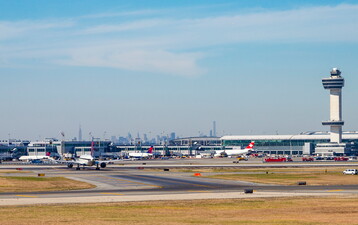Dekarbonisierung von Flughäfen
In light of the net zero emission targets set by airports, there is a pressing need for the rapid and efficient implementation of measures aimed at reducing Scope 1-3 emission at airports (with focus on infrastructure, equipment and operations). Whether it is the shift towards eGSE utilization on the apron, the introduction of sustainable taxi modes for taxiing aircraft, or the decarbonisation of the energy grid: To fully leverage the reduction potential of carbon reducing technologies and processes, it is essential to initiate the necessary planning at the earliest possible stage. As the entire airport system is subject to a large variety of interconnected processes and interdependencies between stakeholders, the implementaiton of such decarbonisation measures can be costly and highly complex.
Some of these measures are mandated by regulatory requirements at the national or European Union (EU) level. For instance, the "Alternative Fuels and Infrastructure Regulation" (Regulation (EU) 2023/1804) is one such requirement, which will require the future deployment of electric ground power units at airports by 2030. It seems reasonable to assume that additional regulatory requirements will be introduced in the near future.
The objective of this training course is to provide a comprehensive overview of the measures for airport decarbonization and associated carbon reduction potentials. The measures are presented separately by airport area (landside, terminal, apron/airside) and categorized into three main groups:
- infrastructure adjustments,
- introduction of new equipment, and
- improving operational procedures
Furthermore, the course covers planning and implementation strategies, including CONOPS development and implementation roadmaps. The presented measures are illustrated by industry best practice, lessons learned, and case studies from airports.
The availability of renewable energy at the airport is a key facilitator for any sustainable and low-emission technologies and equipment. In light of the aforementioned considerations, the technical/aeronautical aspects of generating renewable energy at the airport (e.g. solar farms) are also addressed within the course. In addition, the course offers insight into the regulatory landscape, including present and future requirements (e.g., the New Green Deal/Fit-55 Package) and introduction to accreditation processes for carbon emissions accounting at airports (e.g., ACI Airport Carbon Accreditation).
Please note: This training course is offered in collaboration with Dornier Consulting International GmbH.
Kursinfo
Ort:In-houseSprache:Englisch
Dauer:2 Tage
Anbieter:airsight GmbH
Inhalt
Background: Impact of aviation activities on global climate and the environment around airports
Legal Framework & international/industry initiatives on sustainability in aviation
- EU Level regulatory requirements & Outlook
- Airport/Industry Net Zero Emission Targets
- ACI Airport Carbon Accreditation
Measures for airport decarbonization (infrastructure/equipment/operations)
- Landside / access
- Terminal
- Apron / airside
Renewable energy harvesting at airports (Wind, Solar and Geothermal Energy)
- Aeronautical, technical and biodiversity constraints, assessment methods, workflow strategies
- Energy demand & grid analysis
Implementation planning and roadmapping (incl. stakeholder engagement actions)
Green Financing
Referenten
M.Sc. Christoph Struempfel-Seifert
Leiter der Abteilung Nachhaltige Luftfahrt bei airsight
Herr Struempfel-Seifert ist Experte für nachhaltige Luftfahrt und zuständig für alle Projektaufgaben im Zusammenhang mit nachhaltiger Luftfahrt und Umweltschutz an Flughäfen. Darüber hinaus ist er Lehrgangsleiter, der sein Wissen und seine praktischen Erfahrungen mit anderen nationalen und internationalen Luftfahrtexperten teilt.
Nach seinem Abschluss als Master of Science in Luft- und Raumfahrttechnik an der Technischen Universität Berlin arbeitete er als wissenschaftlicher Mitarbeiter und Dozent am Lehrstuhl für Flugführung und Luftverkehr an der TU Berlin. In seiner wissenschaftlichen Laufbahn konzentrierte er sich auf die Modellierung von Fluglärm und Emissionen, die Lärmmessung und -berechnung von UAS sowie die Optimierung von Flugverfahren im Hinblick auf Umwelt- und Ökoeffizienzziele.
Für airsight hat er mehrere Umweltbewertungen, Lärm- und Emissionsstudien für verschiedene Flughäfen in Deutschland, Luxemburg, den Vereinigten Arabischen Emiraten, Rumänien und den Philippinen durchgeführt. Als anerkannter Experte für die Modellierung von Fluglärm verfügt er über umfangreiche Erfahrungen mit dem Aviation Environmental Design Tool (AEDT) der FAA.
Ein zweiter Schwerpunkt seiner Arbeit ist die Unterstützung internationaler Flughäfen auf ihrem Weg zur Dekarbonisierung mit detaillierten Studien zu erneuerbaren Energien, insbesondere der Implementierung von Solarenergiesystemen, darunter Singapur-Changi, Berlin, Köln, Düsseldorf, Stuttgart und verschiedene andere Flughäfen. Sein Team unterstützt Flughäfen dabei, die Herausforderungen der Zukunft durch neue, nachhaltige Technologien zu meistern, wie z. B. Sustainable Taxiing von Flugzeugen und die Einführung von e-GSE.
Tine Haas
Frau Haas arbeitet als Director Airports Aviation Business Line Mobility bei Dornier Consulting International GmbH.
Zielgruppe
This training course is designed for a diverse audience, including
- Airport operators,
- Ground service provider,
- Airlines,
- ATC/ANSPs,
- Equipment supplier,
- construction companies,
- government/regulatory bodies, and
- other stakeholders (such as local transportation companies for landside access).
Organisatorische Details
airsight bietet diesen Lehrgang auf Anfrage als In-House-Schulung an.
Nach erfolgreicher Kursteilnahme erhalten alle Teilnehmer ein airsight-Zertifikat nach EASA-Trainingsregularien, welches weltweit in der Luftfahrtbranche anerkannt ist.
Über unsere Lehrgänge
Zertifizierte Qualität
airsight verfügt über ein nach ISO 9001 zertifiziertes Qualitätsmanagementsystem, in dessen Mittelpunkt die Maximierung des Kundennutzens steht. Wir arbeiten ständig an Verbesserungen – so auch bei unseren Lehrgängen, die wir auch anhand des Teilnehmerfeedbacks kontinuierlich optimieren.


 Sie wollen 5+ Teilnehmer anmelden? Fragen Sie nach einem In-House-Kurs an Ihrem Standort oder online!
Sie wollen 5+ Teilnehmer anmelden? Fragen Sie nach einem In-House-Kurs an Ihrem Standort oder online!


